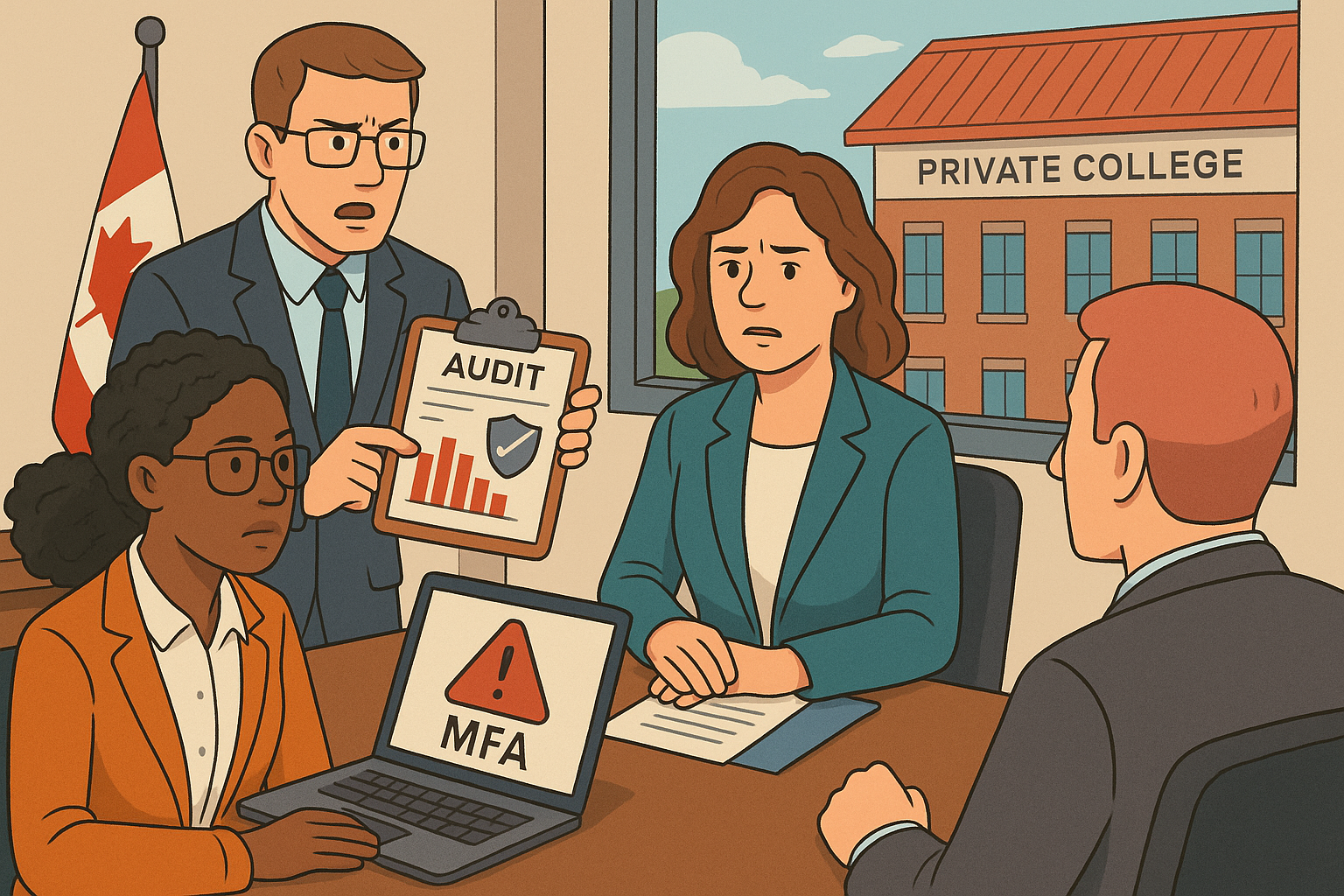External Audit Reveals Insufficient MFA and Logging Controls at Private College; Attestation Required for Funding
The Challenge
An external audit at a private college near Ottawa began as a routine prerequisite for renewed public funding. Policy documents promised 'robust authentication' and 'continuous monitoring.' In practice, multi-factor authentication (MFA) was applied only to a small group of senior administrators and finance staff. Most faculty, staff, students, and contractors still used passwords alone.
The college also lacked centralized logging and monitoring. Authentication records and privileged activity logs were scattered across departmental servers, configured inconsistently, and overwritten within days because of storage limits. As a result, the institution could not reliably detect suspicious activity or confirm whether past unauthorized access had occurred. These gaps conflicted with PIPEDA’s accountability and safeguards principles and did not meet baseline expectations for institutions receiving public funds.
Governance issues compounded the risk. Risk assessments were out of date, change management was informal, and access reviews were inconsistent. The audit’s immediate effect was a deferral of the college’s funding attestation, with findings escalated to the board and the provincial ministry. What began as a compliance check became an operational and reputational problem that affected confidence in the protection of student records, payment data, and HR information.
Our Solution
Audit and Attestation Remediation Program aligned to PIPEDA and Canadian cybersecurity guidance:
– Identity and Access Hardening: Enforce MFA for all users across SSO/IdP, VPN, email, LMS, SIS, and HR/finance. Prioritize phishing-resistant authenticators such as FIDO2/WebAuthn or app-based push with number matching. Restrict SMS to break-glass only.
– Centralized Logging and Monitoring: Deploy a SIEM or cloud-native log analytics platform. Onboard identity, endpoint, firewall, and SaaS/LMS audit trails. Set 12-month retention, enable NTP time synchronization, and use immutable storage for administrator logs. Implement alerting for anomalous logins, impossible travel, excessive failures, and privilege escalation.
– Governance and Documentation: Refresh the risk assessment (aligned to ITSG-33 and ISO 27005), asset and data inventories, and data flows. Formalize change management, quarterly access reviews, and joiner-mover-leaver procedures. Update Authentication, Logging and Monitoring, Incident Response, and Third-Party Risk policies.
– Evidence and Attestation Pack: Map controls to the attestation checklist. Compile screenshots, configuration exports, log samples, standard operating procedures, and training records. Conduct internal testing and remediate residual gaps.
– Training and Awareness: Deliver administrator deep dives on MFA and log engineering, and campus-wide guidance on authenticators and account hygiene.
The Value
- Attestation readiness: Controls are mapped and evidenced to funding requirements and PIPEDA safeguards, which supports certification without rework.
– Risk reduction: Institution-wide MFA typically reduces account takeover risk by 90 percent or more. Centralized monitoring shortens mean time to detect from weeks to hours.
– Operational assurance: Twelve-month log retention with immutable administrator trails strengthens investigations, disciplinary processes, and legal holds.
– Governance uplift: Formalized access reviews and change control reduce audit exceptions and increase board confidence.
– Cost control: Avoided re-audit cycles and use of existing IdP and cloud analytics lower remediation spending and ongoing SOC overhead.
Implementation Roadmap
Phase 0: Mobilize (Week 0 to 1)
Define scope and success criteria. Confirm the attestation checklist. Establish program governance and RACI. Identify systems in scope, including IdP, LMS, SIS, HR/finance, email, VPN, and endpoints.
Phase 1: Baseline and Quick Wins (Week 1 to 3)
Finalize the MFA policy. Disable weak factors. Pilot phishing-resistant authenticators with IT and finance. Centralize IdP and VPN logs. Enable time synchronization and basic alerting.
Phase 2: Scale Controls (Week 3 to 6)
Roll out MFA to all users through SSO. Enforce conditional access policies such as device compliance, geolocation, and sign-in velocity. Onboard LMS and SaaS logs to the SIEM. Set 12-month retention and immutable storage.
Phase 3: Governance and Evidence (Week 6 to 9)
Update the risk assessment, data flows, and inventories. Formalize change management and quarterly access reviews. Refresh policies and administrator runbooks. Deliver targeted training.
Phase 4: Validate and Attestation Pack (Week 9 to 12)
Execute internal control testing. Tune alerts and close findings. Assemble evidence packages that include configurations, screenshots, log samples, and training records. Brief executive sponsors and the board. Submit for independent attestation review.
Standards and References: PIPEDA (Accountability and Safeguards), Canadian Centre for Cyber Security guidance including ITSG-33 for risk management alignment, ISO/IEC 27001 and 27002 for control mapping, applicable contractual and funding terms, and PCI DSS where cardholder data is in scope.


